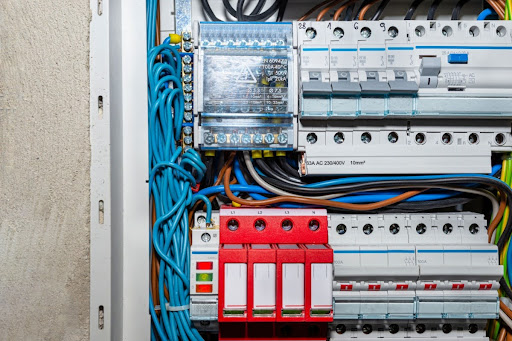Your home’s electricity flows smoothly most of the time, but sudden voltage spikes can wreak havoc on your valuable electronics. These unexpected surges happen when extra electrical current rushes through your wiring, overwhelming devices that weren’t built to handle the excess power. Understanding how these surges occur and taking proactive steps to protect your electronics can save you thousands of dollars in replacement costs.
Grasser Electric has seen what happens when a power surge runs through a home. That’s why we’re shedding light on some of the most simple and effective ways you can fortify your space. Plus, we can help you do it! We offer a full range of residential and commercial electrical services in the St. Louis area, including panel upgrades, whole home surge protector installation, and more.
Causes of Power Surges in Residential Homes
So, what exactly triggers a power surge in the first place? It’s not just a single culprit. The most dramatic and well-known cause is undoubtedly a lightning strike. A bolt of lightning hitting near a power line can send a massive voltage spike rushing through the electrical grid and into your home in an instant. However, these powerful events are actually less common than the more mundane, everyday causes of power surges. A significant number of surges are generated right inside your own house.
Every time a large appliance with a motor, like your refrigerator or air conditioner, cycles on or off, it creates a small fluctuation in the electric current. While these minor surges may not cause immediate and catastrophic damage, their cumulative effect can degrade the internal components of your electronics over time, shortening their lifespan.
Even issues with the local utility company’s equipment can send a surge down the line to your home. Faulty or outdated electrical wiring within your walls can also increase the risk of these events, as it may not be able to handle the demands of modern appliances, creating an unstable electrical environment.
What Happens to Electronics During a Power Surge
Imagine the flow of electricity to your home as the flow of water through a pipe. Your electronics are designed to handle a specific, steady “pressure” of that electricity, which in the U.S. is typically 120 volts of alternating current. A power surge is like a sudden, intense blast of water pressure far exceeding what the pipe and its connections are built to withstand. This overwhelming voltage spike slams into the delicate microprocessors and circuit boards that are the brains of your modern electronics. The result can be immediate and obvious: a computer that refuses to turn on, a television that’s been fried, or a smart-home hub that has gone dark permanently.
The excessive electric current can also generate a significant amount of heat, literally melting and burning these sensitive components. In other instances, the damage is more subtle. A smaller, repeated surge might not destroy a device outright but can lead to a slow, creeping degradation of its performance, what some in the industry call “electronic rust.” Your refrigerator might start making strange noises, or your power supply for your gaming console might fail prematurely, all due to the cumulative stress of these smaller electrical events.
How to Protect Your Electronics from Power Surges
Now for the good news: you have several effective options for protecting your valuable electronics from the damaging effects of a voltage spike. These include:
- Unplug electronics during storms or long trips: If no one is home to monitor conditions, unplugging sensitive devices adds an extra layer of safety during electrical storms or utility maintenance periods.
- Avoid plugging too many devices into one outlet: Overloading circuits increases the risk of surges and can shorten the life of outlets and connected equipment.
- Schedule a professional electrical inspection: A licensed electrician can identify potential hazards, outdated wiring, or breaker panel issues that could contribute to voltage spikes.
- Invest in a whole-house surge protector: These devices are installed at the electrical panel and offer comprehensive protection against surges from both internal and external sources. They work to block excess voltage before it reaches outlets or appliances.
- Replace worn or damaged wiring: Aging wires often lead to inconsistent voltage flow and pose a higher risk of surges or electrical fires.
- Install dedicated circuits for large appliances: Refrigerators, air conditioners, and similar high-demand devices should run on separate circuits to prevent internal surges when they power on.
- Consider grounding upgrades: Proper electrical grounding helps manage excess voltage. If the grounding system is outdated or ineffective, an electrician can bring it up to current safety standards.
Each of these protective steps offers a simple way to maintain safety, preserve expensive electronics, and improve overall electrical performance in the home. Homeowners who combine several of these strategies, especially with help from a licensed electrician, are far more likely to avoid costly damage during unexpected surges.
Guard Your Home & Your Electrics With Proper Surge Protection Today!
Power surges pose a real and expensive threat to your electronics, but proper protection can virtually eliminate this risk. Grasser Electric specializes in comprehensive surge protection solutions that safeguard your valuable devices against voltage spikes from any source.
Our experienced electricians will evaluate your home’s electrical system, recommend the most effective protection strategy, and install professional-grade surge protectors that provide reliable, long-term defense. Don’t wait until a damaging surge destroys your electronics — contact us today to schedule your consultation!

